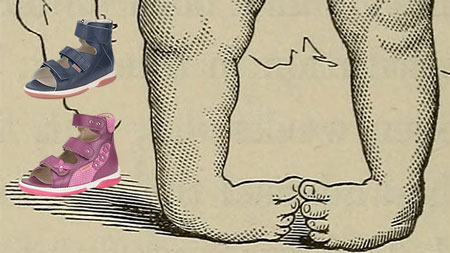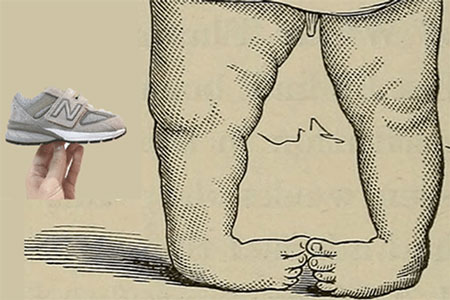Shoes for Babies with Clubfoot – Find the Most Appropriate Shoes
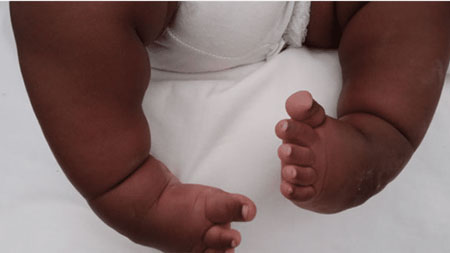
Does your baby have clubfoot and are you having a hard time getting acquainted with this condition and finding the correct shoes? Although I am not a medical professional, I am a passionate shoe fitter on a mission to help children find the perfect pair of shoes for their feet. I will share all of my knowledge and research on clubfoot and I will also provide you with you a selection of the best shoes for babies with clubfoot.
What is Clubfoot?
Clubfoot, also known as “talipes”, is a condition where the baby’s foot or feet are twisted out of shape or position. It can either be one foot or both feet pointing down and inwards with the sole of the foot facing backwards. It’s important to note that not all clubfoot are the same. There are different degrees of clubfoot such as mild, moderate, or severe.
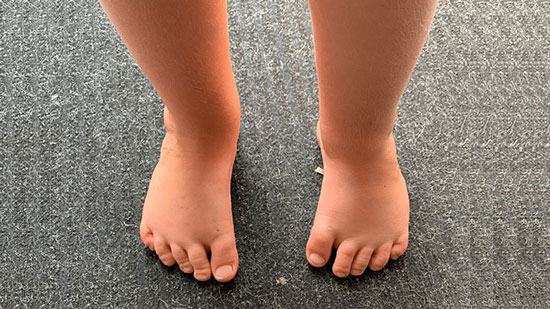
It is worth noting that clubfoot is a common birth defect and is usually an isolated problem for an otherwise healthy newborn baby. Did you know that boys are about twice as likely to develop clubfoot than girls are?
Why Does Clubfoot Happen?
In most cases, the cause of clubfoot remains unknown. There may be a genetic link, as it can likely run in the family. Club foot happens since the tendon (the large tendon at the back of the ankle) is too short, more than usual. It is normally not painful for babies, but it can become painful and make it difficult for a baby to walk if the condition is not treated.
When Should You Consult a Medical Doctor?
Right away! More than likely your doctor will notice clubfoot soon after your child is born, based on appearance and on the signs that I shared with you above. Your doctor will be best suited to advise you on the most appropriate treatment or refer you to a doctor who specializes in bone and muscle problems (i.e., a pediatric orthopedist). It is also somewhat common for the baby’s feet to correct on their own by 3 months, but again it is best to consult with your doctor.
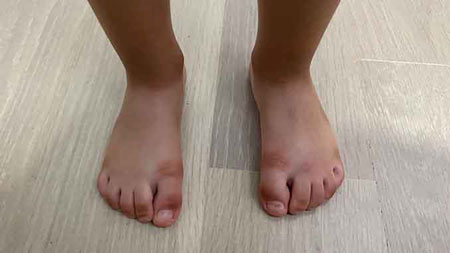
Be Proactive and Don’t Take the “Wait and See Approach”
Timing can be a key role player! Consider that early treatment as well as following the bracing program closely are crucial. Clubfoot responds well to treatment but if left untreated, clubfoot will become worse with age and make it hard for your child to walk.
After the foot position has been corrected, it’s important to hold and maintain the child’s foot and ankle in the correct position by wearing shoes that provide straight lasts, supportive outsoles, and firm heel counters. Allow me to illustrate shortly.
Key Features of Shoes for Babies with Clubfoot
1. Substantial outsole for a stable base of support: Supportive baby shoes for clubfoot should have a supportive structure that promotes proper foot alignment. Look for shoes with a firm heel counter and sturdy soles to provide stability and support to the foot.
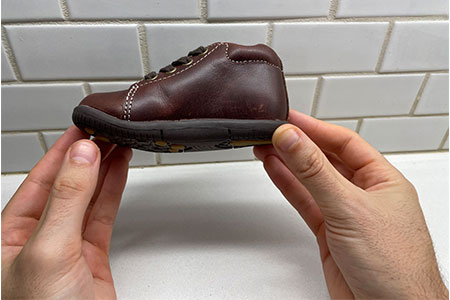
2. Firm heel counter provides ankle and heel support: Shoes with firm heel counters provide essential stability and support. The heel counter is the back part of the shoe that holds the heel in place. A firm heel counter helps maintain the foot’s position, aiding in the correction of the clubfoot.
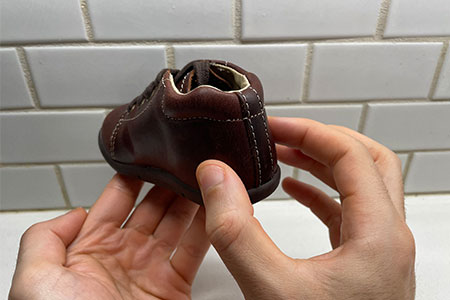
3. Lightweight and flexible at the same time: While support is important, the shoes should also be lightweight and flexible. This combination ensures that the shoes do not restrict movement and allow for natural foot function.
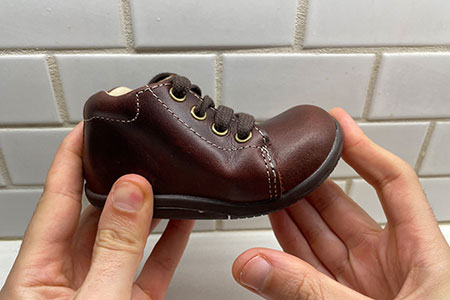
4. Straight lasts to help improve your baby’s foot posture: A straight last refers to the shape of the shoe’s sole. For children with clubfoot, straight lasts are ideal because they provide a stable base that helps in maintaining foot alignment. This feature is particularly important for children who have undergone corrective treatment.
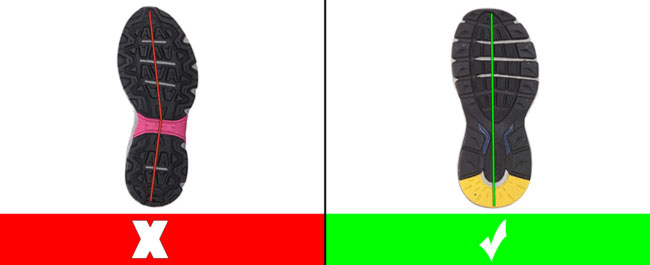
Finally, please find below my selection of the best shoes for babies with clubfoot. Disclosure: Note that we may receive commissions when you click our links and make purchases, this allows us to create free content and resources.
Shoes for Clubfoot Infants – Find The Most Appropriate Shoes
Consider that these shoes will provide compression to the foot, which promotes the recovery of the clubfoot. However, how long these shoes should be worn depends on the severity of the clubfoot for your baby. Therefore, I can’t stress enough that you should always consult with your medical doctor or pediatric orthopedist.
1. Shoe Style Gabi by Memo (Orthopedic Shoe)
These orthopedic shoes for clubfoot are specifically designed to improve foot posture and gait. The higher price point is a common complaint parents have but the investment in orthopedic shoes is often justified by their specialized design and effectiveness in addressing clubfoot.

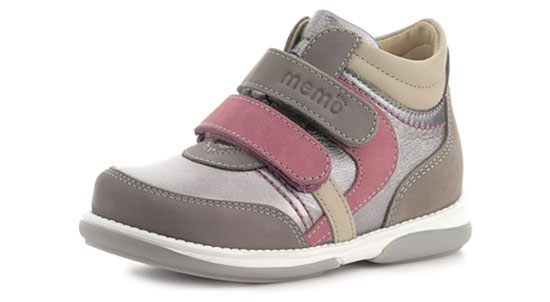
Key Features
- You can order the shoe style Gabi by Memo on Amazon.
- Fits medium and wide feet.
- Also available in a Mary Jane style and a version for older kids called Memo Polo.
- I suggest that you get this shoe a half size larger than your child’s current foot size.
2. Shoe Style Elliott by Stride Rite
These high-top booties by Stride Rite offer excellent support and a comfortable fit, making them a top choice for babies with clubfoot. This shoe is affordable and despite the limited color choices, the Elliott shoes are celebrated for their supportive qualities and comfortable fit.
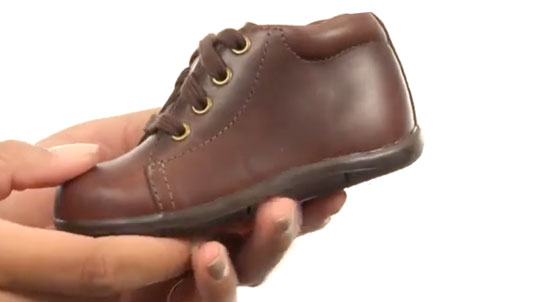
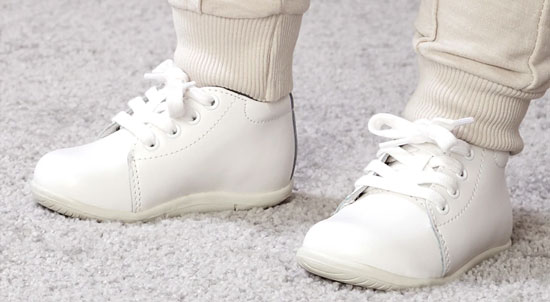
Key Features
- You can order the shoe style SRT Elliot by Stride Rite on Amazon or Zappos.
- Available in medium, wide, and extra wide widths.
- I suggest that you get this shoe a whole size larger than your child’s current foot size.
3. 990v6 by New Balance
These shoes for clubfoot infants are available in wide and extra wide widths. The downside that many parents complain about is the high price tag.
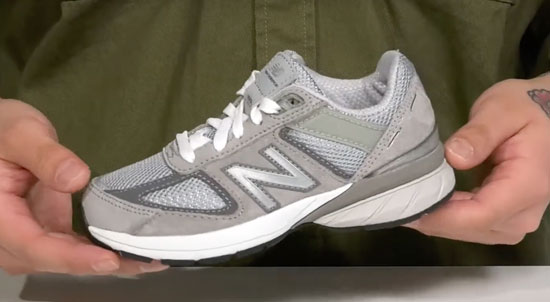
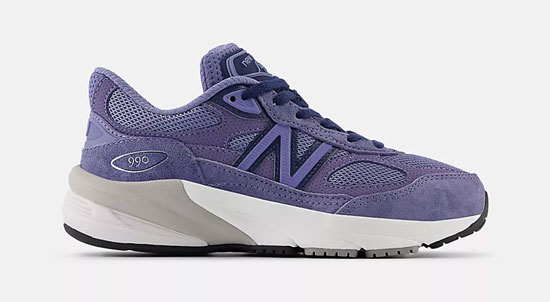
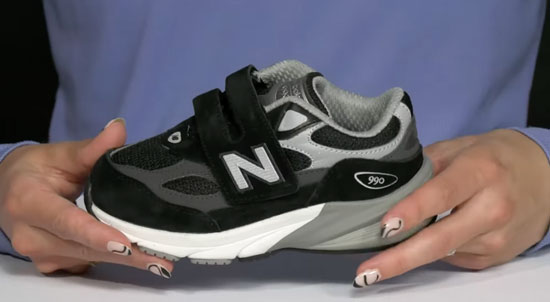
Key Features
- You can order the 990v6 with laces on the New Balance website, Amazon, or Zappos.
- Available in wide and extra wide widths.
- Also available in pink and navy blue.
- There is also a Velcro version of these shoes available in navy blue and pink.
- ENCAP midsole technology provides excellent support and durability.
- I suggest that you get this shoe a half size larger than your child’s current foot size.
4. Shoe style 574 by New Balance
Parents like that the shoe opens up widely and it’s easy to get on and off, making it one of the top sneakers for babies with clubfoot.
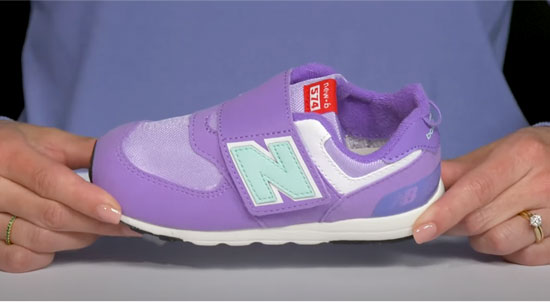
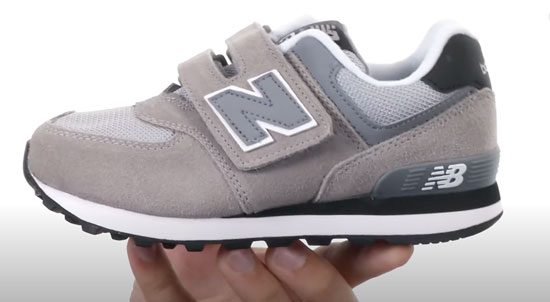
Key Features
- Order the shoe style 574 New-b V1 by New Balance on Amazon or the New Balance website.
- Available in wide and extra wide widths.
- Received the Seal of Acceptance from the American Podiatric Medical Association (APMA).
- Durable rubber outsole pods.
- Synthetic/mesh upper.
- I suggest that you get this shoe a half size larger than your toddler’s current foot size.
5. IKIKI
Ikiki shoes are affordable and ideal for children with clubfoot. The shoes provide oversized openings for easy on and off and have become a favorite among parents for their fun designs and practicality.
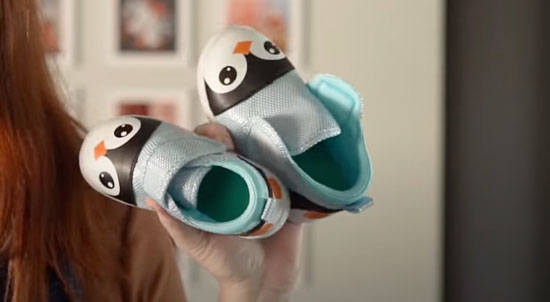
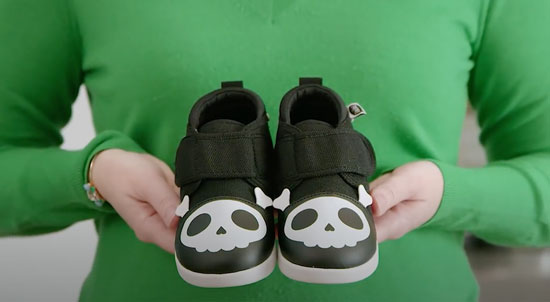
Key Features
- Order the shoe style by Ikiki on Amazon.
- Not available in wide or extra wide widths but fits naturally wide.
- Wide opening to make it easy to put on and take off shoes.
- Synthetic Vegan Leather.
- Squeaks can be turned on/off with a switch.
- I suggest that you get this shoe a whole size larger than your toddler’s current foot size.
6. Shoe Style M2P Journey 3.0 Adapt by Stride Rite
These shoes for clubfoot infants by Stride Rite provide extra depth and extra long Velcro straps to make sure they accommodate wider foot shapes.
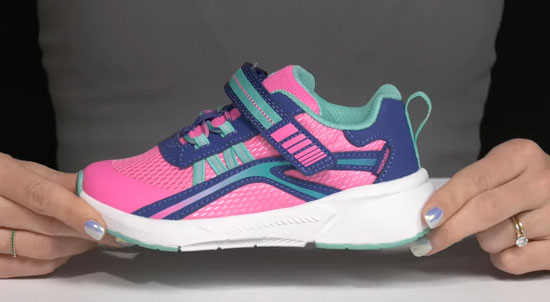

Key Features
- Order the shoe style M2P Journey Adapt by Stride Rite on Zappos or Amazon.
- Available in extra wide widths.
- APMA approved.
- Leather upper.
- I suggest that you get this shoe a half size larger than your toddler’s current foot size.
7. Dean Adapt II by See Kai Run
See Kai Run offers an adaptable line of kids’ shoes that provide extra long straps and extra depth to allow the baby’s feet to sit deeply inside of the shoes.

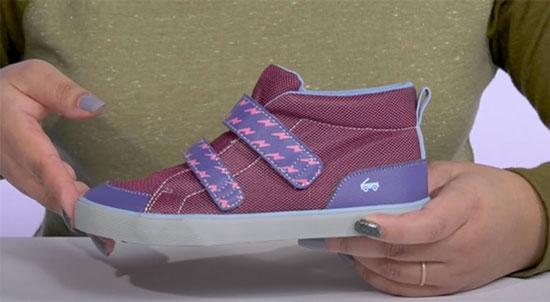
Key Features
- Order the shoe style Dean Adapt II by See Kai Run on Zappos or Amazon.
- Not available in wide or extra wide widths but fits naturally wide.
- I suggest that you get this shoe a whole size larger than your child’s current foot size.
8. Shoe style Holly Mary Jane by Stride Rite
Known for its adjustable straps and roomy design, this adaptable Mary Jane is supportive and ideal for accommodating clubfooted babies. The shoe’s design allows children to wear this shoe for casual wear or dressier occasions.
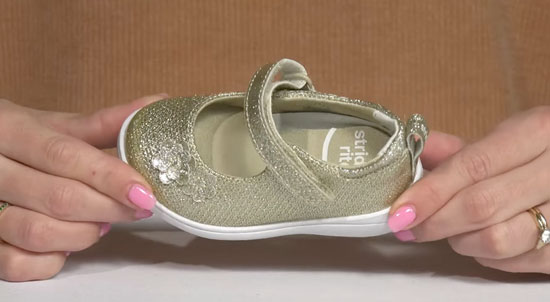
Key Features
- Order the shoe style SR Holly by Stride Rite on Zappos or Amazon.
- Available in extra wide widths.
- I suggest that you get this shoe a whole size larger than your child’s current foot size.
Do Most Babies with Clubfoot Have Wide Feet?
Yes, they do, and sometimes this makes it harder for parents to get the shoes on and off. The good news is that all of the shoes I recommended are available in wide and extra wide widths, and have oversized openings, which makes it easier for parents to get the shoes on and off.
Ordering the Correct Shoe Size Online
Ordering shoes online can be convenient, but it also presents challenges, particularly when sizing for a child with clubfoot. For this reason, I created a virtual shoe fitting service that will help you retrieve your child’s shoe size from home. In that resource, you will find out whether your baby has narrow, medium, wide, or extra wide feet. I also will be able to determine whether your baby has a high instep or not.
Can Orthopedic Shoes Replace Braces or Casts?
Orthopedic shoes are not a replacement for medical treatments such as braces or casts. They should be used in conjunction with, not in place of, braces or casts, which are specifically designed to correct the foot’s position. Always follow your healthcare provider’s recommendations for managing clubfoot.
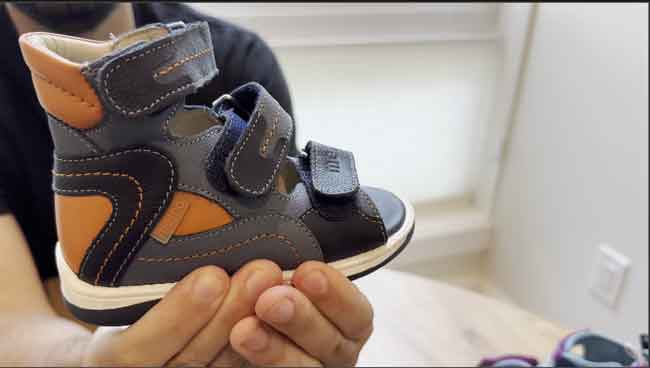
Does Your Child Have a Big Size Difference Between Their Feet?
It’s not uncommon for children, especially those with clubfoot, to have feet of different sizes. If there is a significant size difference (more than a full shoe size and a half) , consider purchasing two different shoe sizes to ensure both feet are properly supported.
This consideration is crucial because wearing the wrong size can lead to discomfort and hinder the effectiveness of the treatment. Some shoe brands offer customization options or sell individual shoes to accommodate this need, helping to ensure that both feet receive the necessary support and alignment. There are certain shoe companies that will charge you full price for the first pair and give you 40% off for the second one.
What Are The Most Common Signs of Clubfoot?
1- You will notice that the top of the foot is usually twisted downward and inward, increasing the arch and turning the heel inward.
2- The foot may be turned twisted out of shape or position so noticeably that it looks as if it’s upside down.
3- You may be able to tell that the affected leg or foot may be slightly shorter.
4- The calf muscles in the affected leg are usually underdeveloped and this may be visible and easy to spot.
Thank you for reading! I hope you found helpful this post on shoes for babies with clubfoot. Please feel free to share this post with your community on social media as well as your experiences in the comments section below. Keep in mind that if you have any questions or need any assistance, you can also contact me via email and I will get back to you as soon as possible.
“Clubfoot.” Mayo Clinic, Mayo Foundation for Medical Education and Research, 28 June 2019, www.mayoclinic.org/diseases-conditions/clubfoot/symptoms-causes/syc-20350860.
“Clubfoot: Boston Children’s Hospital.” Boston Children’s Hospital, www.childrenshospital.org/conditions-and-treatments/conditions/c/clubfoot.

